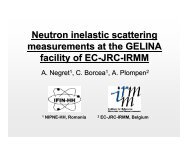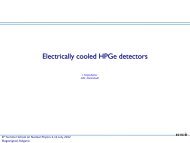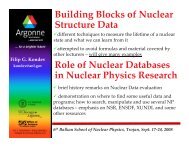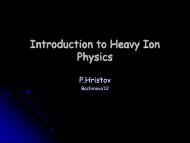Peter Egelhof GSI Darmstadt, Germany 8th. International ... - Bulgaria
Peter Egelhof GSI Darmstadt, Germany 8th. International ... - Bulgaria
Peter Egelhof GSI Darmstadt, Germany 8th. International ... - Bulgaria
Create successful ePaper yourself
Turn your PDF publications into a flip-book with our unique Google optimized e-Paper software.
Nuclear Structure Studies on Exotic Nucleiwith Fast Radioactive Beams -Present Status and Future Perspectives at FAIR<strong>Peter</strong> <strong>Egelhof</strong><strong>GSI</strong> <strong>Darmstadt</strong>, <strong>Germany</strong><strong>8th</strong>. <strong>International</strong> Balkan School on Nuclear PhysicsBlagoevgrad, <strong>Bulgaria</strong>July 3 - 12, 2012
I. Introduction: Phenomena and Burning QuestionsII. Experimental TechniquesIII. Nuclear Physics with Radioactive Beams at the Present <strong>GSI</strong>Facility – Some Selected Examples1. Elastic and Quasielastic Scattering – The Structure of Halo Nuclei2. Inelastic Scattering – Giant Resonances and the EOS of Nuclear Matter3. Nuclear Physics with Stored Radioactive Beams – A Laboratoryfor Nuclear AstrophysicsIV. Future Perspectives at FAIRV. ConclusionsNuclear Structure Studies on Exotic Nucleiwith Fast Radioactive Beams -Present Status and Future Perspectives at FAIR
I. Introductionmethods of nuclear structure studies:⇒ spectroscopy on stored exotic nuclei (Schottky, etc.)beam of exoticnuclei A X1H - target1H ( A X, 1 H) A X⇒ light ion induced direct reactions: (p,p), (p,p'), (d,p), ...quasielastic scattering, Coulomb excitation,...⇒ to investigate exotic nuclei: inverse kinematicsprotondetectorpast and present experiments:light neutron-rich nuclei: skin, halo structuresheavier neutron-rich nuclei: new collective modesmasses, lifetimes⇒⇒ powerful experimental setups: IKAR: active targetLAND: high energy neutronsESR: stored exotic nucleifuture perspectives at FAIR:Heavy-IonSpectrometerHeavyionsUHVSi stripH, nHe,⇒ explore new regions of the chart of nuclidesand new phenomena⇒ use new and powerful methods:EXL: reactions at internal targets of storage ringsELISe: electron scattering on exotic nucleiGas jetNeutrons /Charged EjectilesRecoilDetectorBeam inStorage RingGas jetScintilla50 cm
Nuclear Physics with Radioactive BeamsNuclear Structureof exotic nucleiNeutron-Protonasymmetric matterNuclear Astrophysics
Introduction: Phenomena and Burning Questions –Regions of InterestFission and Fragmentation StudiesNew Mass Measurements2-p RadioactivityGiant DipoleResonanceNuclearAstrophysicsNew β-decay Branches100SnB=0 p132SnB=0 nSoft Dipole ModePionic AtomsNew Fission FragmentsB=4MeVFr-processStructure ofHalo Nuclei8B11LiShells far off StabilitySkin Nuclei
Introduction: Phenomena and Burning Questionsregions of interest:114⇒ towards extreme isospin forall nuclides up to uraniumphysics interest: ground state properties8282 202 8(masses, lifetimes, charge and matter distributions, skins, halos) exotic decay modes285082822050known exotic nuclei single-particle structure evolution (new magic numbers,new shell gaps, shell quenching, spectroscopic factors, drip lines) NN correlations, pairing and clusterization phenomena new collective modes, giant resonance strenght parameters of the nuclear equation of state in-medium interactions in asymetric and low-density matter astrophysical r and rp processes, understanding of supernovae126TERRA INCOGNITAunknown exoticpathways nuclei of stellarnucleosynthesis
Introduction: Phenomena and Burning QuestionsScattering experiments
What Happens in Neutron-Rich Nuclei at High Isospin?Asymmetry in N to Z ratioAsymmetry in energy (Fermi surface)Asymmetry in densityDiffusenessLow-density neutron matterCoupling to the continuumClusterizationAmplification/reduction of certain terms in theeffective N-N interactionIsopsin dependence of N-N correlationsDecoupling of n and p ?New degrees of freedom ?New collective modes ?
Halo-Nuclei – a New Phenomenonof the Structure of NucleiDensity Distribution of Nuclear Matter11 LiLi208 PbPbextremely neutron-rich nuclei:neutron halostable nuclei:neutrons and protons equally distributed
The Phenomenon of Borromean Nuclei11Li as a Borromean nucleus:11Li: bound10Li: unbound2n : unboundCore9LiV cnV cnnnV nnn
The Radial Shape of Nuclei: from Stable to very Neutron - Richneutron - rich
Introduction: Phenomena and Burning QuestionsSensitivity of the Skin Thickness on Parameters of the EOS of Nuclear Matter:2 4E(ρ , α)= E(ρ,0) + S ( ρ)α + Ο(α ) , α =21 ∂ E(ρ,α)S2 ( ρ)= | =22 ∂αα = 0p0∆K0= a4+ ( ρ − ρ0)+ ( ρ − ρ0)22ρ 18ρ0+ ...example: Sn isotopesat the nuclear surface:almost pure neutron matter probe isospin dependence ofeffective in-medium interactions sensitivity to the symmetry energy(parameter a 4of the EOS)02N − ZA2 (S 2= Symmetry Energy)Skin thickness R n- R ptheoretical prediction: P.-G. Reinhard
Introduction: Phenomena and Burning QuestionsThe Nuclear Equation of State and its Dependence on n-p Asymmetry and Density:Neutron Starsymmetry energy and its density dependence close to saturation density→ properties of n-rich nuclei ?symmetry energy at higher densities→ reactions with n-rich nuclei ?
The Collective Response of the Nucleus: Giant ResonancesElectric giant resonancesIsoscalarIsovectorPhoto-neutroncross sectionsMonopole(GMR)65 CuDipole(GDR)Quadrupole(GQR)Berman and Fulz, Rev. Mod. Phys. 47 (1975) 47120 Sn208 Pb
The Collective Response of the Nucleus: Giant ResonancesM. Itoh
Investigation of the Giant Monopole Resonancein Doubly Magic Nuclei by Inelastic α-Scattering GMR gives access to nuclear compressibility K nm(Z,N) ~ ρ 02d 2 (E/A) / dρ 2 | ρ0 key parameter of EOS investigation of isotopic chains arround 132 Sn, 56 Ni, … with high δ = (N-Z)/A disentangle different contributions toK A= K vol+ K surfA -1/3 + K sym((N-Z)/A) 2 + .....GMR208PbGMR132Sn
The Collective Response of the Nucleus: Giant ResonancesElectric giant resonancesMonopole(GMR)IsoscalarIsovector?new Photo-neutroncollective softdipole cross mode sections(Pygmy resonance)Prediction: RMF(N. Paar et al.)Dipole(GDR)132 SnQuadrupole(GQR)
Introduction: Phenomena and Burning QuestionsShell Quenching due to diffuse surface of exotic nuclei:J. Dobaczewski, , et al.Phys.Rev. C53 (1996) 2809
The Radial Shape of Nuclei: from Stable to very Neutron - Richneutron - rich
Introduction: Phenomena and Burning QuestionsChange of shell structure due toChange in Fermi energyChange of diffuseness (LS coupling?)Change of effective N-N interaction(amplification/reduction of certain’’WS’’contributions, e.g., Tensor force, 3-body force)’’HO’’(c)
New Magic Number N = 16N=20 shell gapvanishesNew shellclosure at N=16All experiments consistently suggest avanishing of the N=20 shell gap ( 28 Ounbound) and theappearance of a shell closure forN=16 (large spectroscopic factor,high-lying 2 + state)for the neutron-rich oxygen isotopesZ=14 → Z=8Removing 0d 5/2protons→ less binding for 0d 3/2neutronsT. Otsuka et al.,PRL87(2001)082502PRL95(2005)232502
Introduction: Phenomena and Burning Questions:The Nucleosynthesis of Chemical ElementsNucleosynthesis inbinary systemsProton numberFeNucleosynthesisin AGB starsrp-processFusion up to ironp-processs-processr-processTerra IncognitaNucleosynthesisin supernovaeBig Bang nucleosynthesisNeutron numberHeavy elements (A>56) areproduced by thes-process (~50%) and ther-process (~50%)
Introduction: Phenomena and Burning Questions
Introduction: Phenomena and Burning Questions
Introduction: Phenomena and Burning QuestionsThe challenge: For the understanding of nucleosynthesis and stellar dynamics weneed to know properties of many exotic nuclei.Nuclear input: half lives, masses, reaction ratesAstrophysical calculationsComparison to observationrapid proton capture(rapid neutron capture )
II. Experimental Techniques… using SIS energies(several 100 AMeV)storagerings /traps26
Light-Ion Induced Direct Reactions elastic scattering (p,p), (α,α), …nuclear matter distribution ρ (r), skins, halo structures inelastic scattering (p,p’), (α,α’), …deformation parameters, B(E2) values, transition densities, giant resonances transfer reactions (p,d), (p,t), (p, 3 He), (d,p), …single particle structure, spectroscopic factors, spectroscopy beyond the driplines,neutron pair correlations, neutron (proton) capture cross sections charge exchange reactions (p,n), ( 3 He,t), (d, 2 He), …Gamow-Teller strength knock-out reactions (p,2p), (p,pn), (p,p 4 He)…ground state configurations, nucleon momentum distributions
II. Experimental TechniquesThe Present <strong>GSI</strong> Accelerator Facilities:UNILAC: universal linear acceleratorall ions ( 1 H ... 238 U)E = 3 - 20 MeV/uSIS:ESR:FRS:heavy ion synchrotronE = 100 - 2000 MeV/u0 50mexperimental storage ringbeam cooling⇒ excellent beam qualitiesUNILACfragment separatorprojectile fragmentation, fission⇒ secondary radioactive beamswith energies E ≥ 100 – 1000 MeV/utransfer channelexperimental hall(3 – 20 MeV/u)experimental hall(up to 2000 MeV/u)SISFRSESR
The Present Radioactive Beam Facility at <strong>GSI</strong>FRS: In-Flight Separator & High-Resolution SpectrometerSecondary Beam Branches3SIS121. Decay Spectroscopy, Reactions,High-Resolution Particle-γ Measurements2. Masses, Lifetimes, Isomeric Beams,Direct Reactions3. Reactions Studies (Complete Kinematics)Active Target IKAR
Production of Radioactive Ion BeamsIN-FLIGHT:relativistic heavy ions(50 MeV/u – 1 GeV/u)- fragmentation- fission (elm. or nuclear induced)ISOL:- spallation (~1 GeV protons)- fission: p-induced, fast neutrons(d beam), slow neutrons (reactor),photons (e - beam)H. Geissel, G. Münzenberg, K. Riisager, Annu.Rev. Nucl. Part. Sci. 45 (1995) 163- fusion/evaporation, multi-nucleontransfer
Production of Radioactive Beams at Relativistic Energies(750-1000) MeV/u
Production and Separation of Exotic Nuclei with the FRSBe-18O800 MeV/u6He717 MeV/uFirst SelectionFirst and Second Selection515 B5411 Be12 Be4charge Z328 Li6 He9 Licharge Z326 He9 Li13 H13 H2 4 6 8 10 12 14 16mass A2 4 6 8 10 12 14 16mass A
Why Fast Radioactive Beams?Production Aspects:“chemical blindness” (independent on on chemistry)access to to shortest lifetimeshigh high production rateskinematical forward focussingExperimental Aspects:allows thick thick targets (high luminosities)fully fully stripped ions ions (clean magnetic analysis)high high efficient in-flight particle tracking and and identificationPhysics Aspects:high high cross sections (Coulomb Excitation)clean analysis (short interaction sudden process,small in in medium effects,reduced re-scattering)<strong>GSI</strong>: up to 1 GeV/AOther Laboratories(up to ~ 0.1 GeV/A):GANIL / FranceMSU / U.S.RIKEN / Japanmrad
Direct Reactions in Inverse Kinematicsclassical method to observe spectroscopic information:⇒ light ion induced direct reactions: (p,p), (p,p’), (d,p), …(before RIB-facilities: limited to stable nuclei)aim:method:use radioactive beams from RIB-facilities fornuclear structure studies off stabilityInverse Kinematicsbeam of exoticnuclei A X1H - target1H ( A X, 1 H) A Xproton-detector
II. Experimental TechniquesExperimental challenges:* low production cross sections – low beam intensities* large emittance beams* high beam energies ↔ sub-MeV resolution (structure and astrophysics)→ development of appropriate experimental conceptsinstrumentation + selective reactions
The LAND Reaction Setup at <strong>GSI</strong>LAND: Large Area Neutron DetectorMixed beamCharged fragmentstracking → Bρ ∼ A/QβγToF, ∆ELANDNeutrons~12 mToF, x, y, zprojectiletrackingBeamPhotonsCrystal Balland TargetALADINlarge-acceptance dipoleExcitation energy E * from kinematicallycomplete measurement of all outgoingparticles ( invariant mass method )
Application of Active TargetsConcept of Active Target:Target = Detectorbeamrecoildecay pX,Ydriftchamberheavy reactionproductactive targetdetectorlight particledetectormagneticspectrom.⇒ advantage:• low threshold• high detection efficiency (rel. thick target)
ESR: Experimental Storage RingStored Radioactive Beams
The Experimental Storage Ring ESR at <strong>GSI</strong>ESR: B. Franzke, NIM B 24/25 (1987) 18Stochastic cooling: F. Nolden et al., NIM B 532 (2004) 329Electron cooling: M. Steck et al., NIM B 532 (2004) 357
Electron Cooling of Heavy Ion Beamselectron collectorelectron gunhigh voltage platformmagnetic fieldelectron beamion beamion intensitybefore coolingafter cooling0.97 1 1.03rel. ion velocity v/v 0






